.
.
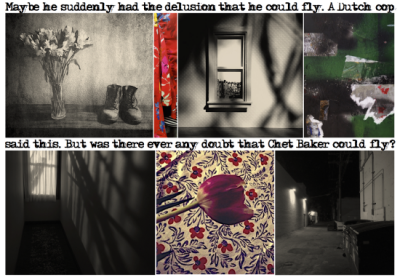
“The Death of Chet Baker, 13 May 1988” is one of several photo-narratives in Charles Ingham’s new series devoted to his love of jazz music, “Charles Ingham’s Jazz Narratives”
These photo-narratives are provocative and meaningful– connecting time, place, and subject in a way that ultimately allows the viewer a unique way of experiencing jazz history.
To enhance the opportunity for appreciation of this artistic series, in the coming weeks “Charles Ingham’s Jazz Narratives” will be featured on Jerry Jazz Musician three-at-a-time, and will include the artist’s description of each piece.
.
This edition’s narratives, found below the artist’s introduction, are:
“The Death of Chet Baker, 13 May 1988“
“Out There Somewhere“
“Dreaming of Bird“
.
.
_____
.
.
Charles Ingham introduces his “Jazz Narratives” series
.
…..Jazz has always been there for me. Music is an essential part of my life, and I have eclectic tastes, but there has always been jazz music. At seventeen, I’m at a Rahsaan Roland Kirk concert in my hometown of Manchester, England, stunned by the transgressive beauty of this man’s performance. At fifty-seven, my wife has died, and I can’t bear to hear lyrics, so it’s Kind of Blue and Trane ballads. And today I’m listening to ‘Round Midnight, Monk alone at the piano, stunningly honest and almost unbearably intimate.
…..So as an artist I need to give something back, but make it my own, and make it new.
…..As a conceptual artist, my photo-narratives are hybrid forms, transgressing distinctions between the verbal and the visual: the image as text. My art represents a combinatory aesthetic; each work constitutes a whole made up of parts, creating something of a symbiosis: the words, the images (abstract and referential), the space between images, the subjects, the reference to specific individuals, places, or times. As the artist Alexis Smith says of her collages and assemblages: “It’s fused into a whole where they seem like they’ve always been together, or were meant to be together. The people that look at them put them together in their heads.” Some visual references are obvious; some of the bones, sinews, and other connective tissue that hold a particular narrative together work within the piece’s own logic, a logic that viewers find for themselves. Here, the artist makes the work, and that work has an agenda, but a significant part of that agenda is for the viewer to find something of (or for) themselves within these images and words.
…..Each work in this series of “Jazz Narratives” is anchored by a person (a musician) and a related place. I am especially interested in the “aura” of these places. Sometimes, the place remains relatively unchanged seventy years after the musical fact; sometimes, only a physical street number remains, if that. What matters is that, for the artist and the viewer, this aura remains. This, say, is 151 Avenue B, on the Lower East Side; the brownstone is easy to miss if you are walking along the east side of Tomkins Square Park, but if you know that Charlie Parker lived there, it has become something more than the stone and glass of the place. 4201 S. Central Avenue, Los Angeles, is an anonymous mixed-use building, but there’s the number above the glass doors; 4201 S. Central is the Downbeat Club. Here, in 1945, Clora Bryant first heard bebop: here, on this corner, and that corner is still here, as is that night and all those other nights.
…..Some years ago in Brooklyn, I went looking for 99 Ryerson Street, where the poet Walt Whitman had lived when Leaves of Grass was first published. The fact that Whitman had lived here had only recently been discovered, and the 1850s wood-frame house was unmarked and unchanged except for aluminum siding and the addition of an extra floor. It is the only surviving Whitman residence in Brooklyn and Manhattan. Standing on the original bluestone sidewalk slabs, I was looking at Whitman, whose vision of America was a primary reason for my decision to emigrate to the United States. In my excitement, I crossed the street and spoke to an elderly man sitting on the stoop opposite. “Do you know that Walt Whitman lived in that house?” I asked, clearly appearing to be a madman. The neighbor looked up at the crazy person: “Is that the guy who is renting a room?” For him, the aura was not visible.
…..These pieces are works of homage; I am making some kind of unsentimental pilgrimage to each of these apparently anonymous street addresses. And I am conjuring ghosts; they are still alive in these places as they are in their recordings. The music may have been recorded in 1947, but they are playing it now. You can hear that. And, if I am successful, you can see the musicians in my art.
.
_____
.
.
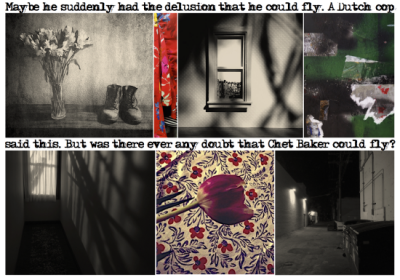
.
The Death of Chet Baker, 13 May 1988
(Prins Hendrikkade 53, Amsterdam)
2019
.
…..
…..At around 3 o’clock on the morning of 13 May, 1988, Chet Baker fell from the window of his third-floor room in the Hotel Prins Hendrik. Based upon the needle tracks in Baker’s arm, Criminal Inspector Rob Bloos asked, “How did it happen? He was intoxicated from the drugs, of course. Heroin puts you into a kind of half-conscious state. Maybe he suddenly had the delusion he could fly.” Only Inspector Bloos was deluded.
.
___
.
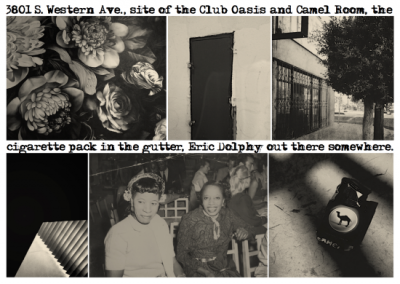
.
Out There Somewhere
(3801 S. Western Ave., Los Angeles)
2019
.
…..The text alludes to the Eric Dolphy tune “Out There.” In Ted Gioia’s West Coast Jazz, Dolphy’s friend Lillian Pollen talks about how she would “fall by the Oasis” (I love fall by), and that Dolphy would always want to know if he sounded like Bird, whom Dolphy “worshipped.”
…..A couple of months before I made this piece, I had bought an original photo on eBay of two young African-American women in a club. I suspect that the fairly large photograph was taken by a wandering photographer offering to take (for a fee) the photographs of patrons. It’s an informal photo, but because of its size, I don’t believe that it’s a snapshot (most likely shot, rather, on a Graflex Speed Graphic).
…..When the photograph arrived, on the back someone had written “Oasis Club, 3801 South Western Ave., 9-1-51.” Bird, Coltrane, Dizzy, Dexter Gordon had all played this “exotic, Middle-Eastern themed club” (actually, Club Oasis). Today, the corner building is, of course, abandoned and boarded up, having most recently been a Mexican pharmacy (the outline of lettering is still visible on the facade). At the site, I had a productive time shooting in preparation for a new work. But there was a little piece of magic at the end of the shoot. I was walking back to the car but stopped and turned around, thinking that I should go back to see if I could find some kind of artifact (a literal souvenir) that would in some way carry the aura of the place. I was looking for anything, but there in the gutter, right outside the door, was an empty pack of Camel cigarettes (with that wonderful design). The full name of the club was the “Club Oasis and Camel Room.” Damn!
.
___
.
.
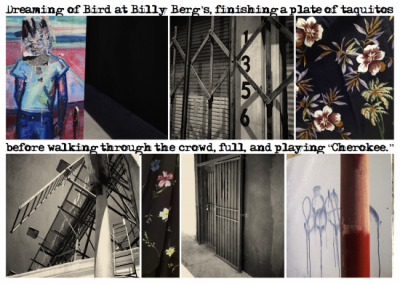
.
Dreaming of Bird
(1356 N. Vine Street, Hollywood)
2019
.
…..Berg’s Vine Street club is best known for booking the Dizzy Gillespie Quintet for eight weeks from early December 1945 to early February 1946, the first appearance for Gillespie and Parker on the West Coast. On the first night of the Quintet’s performance, Parker was initially absent, making his way to the stage late in the second set. Parker’s tardiness is often attributed to his general – and sometimes genuine – unreliability; in fact, Bird had been in the place all along, at the back, exploring the club’s Mexican food. Food first; then art.
.
.
All pieces are archival inkjet prints, 4½ x 6½ inches, framed to 14 x 14 inches. For more information, visit charlesingham.com
.
.
To see Volume 1 of this series, click here
To see Volume 2 of this series, click here
To see Volume 3 of this series, click here
To see Volume 4 of this series, click here
To see Volume 5 of this series, click here
To see Volume 6 of this series, click here
To see Volume 7 of this series, click here
To see Volume 8 of this series, click here
To see Volume 9 of this series, click here
.
___
.
.
.
photo by Jacqueline Ramirez
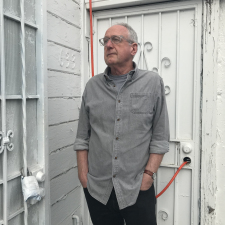
.
Born and educated in England, Charles Ingham moved to California in 1982. He has always been interested in hybrid forms and the intersection of literature and the visual arts, his photography often seeking to transgress the traditional boundaries separating the verbal and the visual.
Ingham lives in San Diego and shows his work at Distinction Gallery in Escondido. He recently had three pieces accepted for the 28th Annual Juried Exhibition at the Athenaeum Music and Arts Library, La Jolla. He also had two pieces shown in the “Six-Word Story” exhibitions at Front Porch Gallery, Carlsbad, and the Oceanside Museum of Art.
His work can be found.at his website: charlesingham.com
.
.
.
.
.
.




























